Japan April travel seasonal highlights, themes and attractions
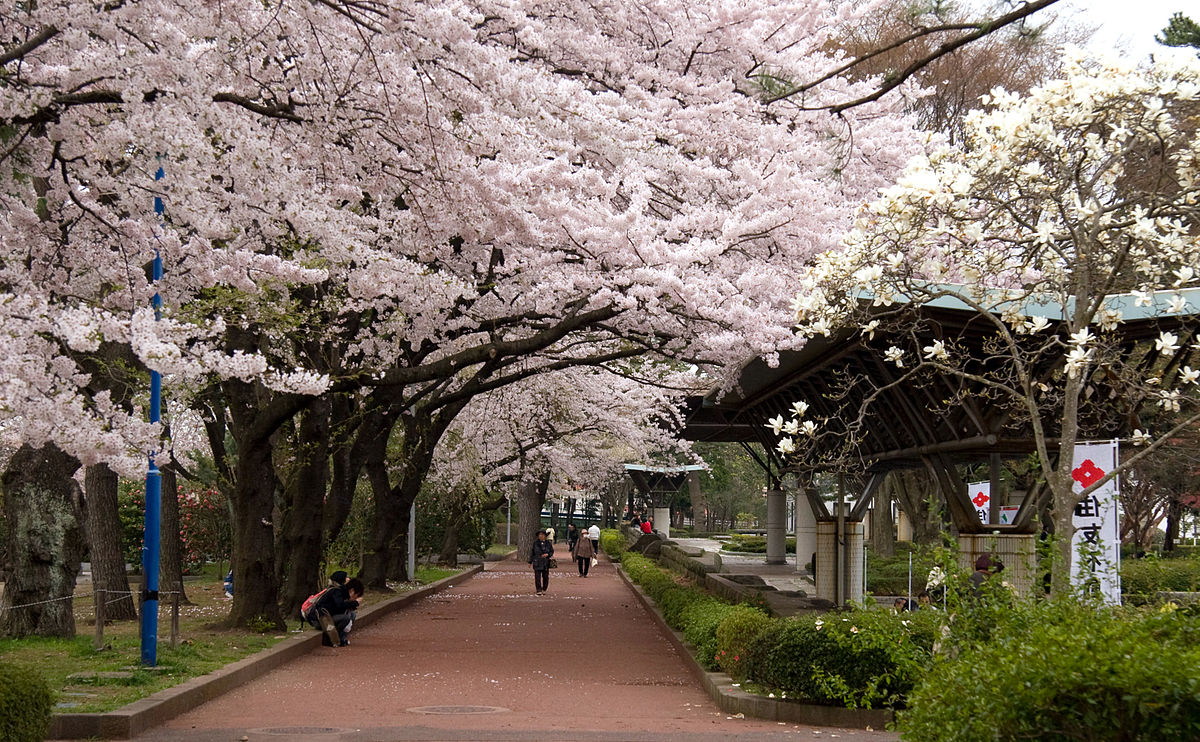
Japan April travel season is one of the busiest tourism months for one single reason: cherry blossoms! Japan’s super peak spring high season includes the last 10 days of March, all of April and the first week of May (i.e., Golden Week). And 90% of the overtourism in key locations, especially on weekends, are Japanese domestic travelers. Nearly 50 million Japanese tourists visit Kyoto every year! Thirty percent in peak spring and another thirty percent in peak autumn (Oct 15-Dec 15, depending on climate changes). April travel super peak season, and overtourism issues, only apply to Kyoto, Nara, Kanazawa, and popular weekend “cherry blossom” destinations near Tokyo (including Kamakura, Nikko, Hakone-Mount Fuji and Lake Kawaguchi-Mount Fuji). So, weekdays are the best for day trips from Tokyo during April. However, Kyoto (and Nara) are completely packed with Japanese domestic tourists in super peak season and this can make things a little challenging. First, accommodation is hard to find pretty much from mid-February onward, with some exceptions. Your Japan Private Tours has 30 years of specialty accommodation booking experience all over Japan and we can certainly find places to stay in Kyoto that you may not have tried. Second, with 10-12 million domestic Japanese tourists visiting Kyoto in April (with 50-52 million Japanese visitors annually!) finding the serenity you dreamed of in Kyoto isn’t as easy to find. And getting around can be a real headache: forget about using a taxi from about noon to 18:00 during April in Kyoto. You have to take advantage of walking, trains, trams and the subway to save time. Kyoto’s public transportation system is excellent and at its farthest edges taxis become practical and convenient again in super peak season. Getting out early is key! Again, Your Japan Private tours has unique strategies for getting around almost all the difficulties of super peak season, i.e. April, in Kyoto. Just ask!
The weather in April is still pretty chilly and in the first days of the month snow is still possible. The daytime temperatures go up to about 16 C (61 F) in Kyoto and Tokyo in April, while at night the low are usually about 10-12 C (50-54 F). However, towards the end of the month, likely because of climate change, the days can be much warmer. Lighter layers and a wind shell is all you will need in April in Japan.
In the Japanese tea ceremony, the month of April has been poetically captured with “goma” associations that capture the essence of each 10-day period: early April, mid April, late April. These key words and themes that have been classically repeated in Japan for more than 1,200 years. The April goma key words can help you “imagine” what to expect when you travel in Japan in that month. Early April themes: Hana matsuri cherry blossom festivals. Mid-April themes: Hana no shizuku or the dew on spring flowers. Late April themes: The first signs of the Boy’s Day and symbolic Koi Nobori carp banners (Boy’s Day is now officially Children’s Day, May 03, and most of May).
And in late April, when the first rice is planted in certain areas of Japan (i.e. close to sea level), travelers can enjoy the classic pleasure of hearing frogs singing in choruses at the edges of rice fields.
And April in Japan is also strongly linked to materials from the cherry tree, especially in the Japanese tea ceremony. Utensils carved from cherry wood. Containers and other things wrapped in cherry bark. chashaku carved from cherry wood, hana ire made from cherry bark, natsume with a night view of cherry blossoms.
- Japan April travel food highlights
- Japan April travel tree and flower highlights
- Japan April travel event & festival highlights
- Japanese expressions for cherry blossom viewing
- April Japanese Folk Tale: Cherry Blossom Old Man
- April interview: Japan’s 16th-generation cherry tree expert
Content by Ian Martin Ropke, owner of Your Japan Private Tours (est. 1990). I have been planning, designing, and making custom Japan private tours on all five Japanese islands since the early 1990s. I work closely with Japan private tour clients and have worked for all kinds of families, companies, and individuals since 1990. Clients find me mostly via organic search, and I advertise my custom Japan private tours & travel services on www.japan-guide.com, which has the best all-Japan English content & maps in Japan! If you are going to Japan and you understand the advantages of private travel, consider my services for your next trip. And thank you for reading my content. I, Ian Martin Ropke (unique on Google Search), am also a serious nonfiction and fiction writer, a startup founder (NexussPlus.com), and a spiritual wood sculptor. Learn more!
Japan April travel food highlights
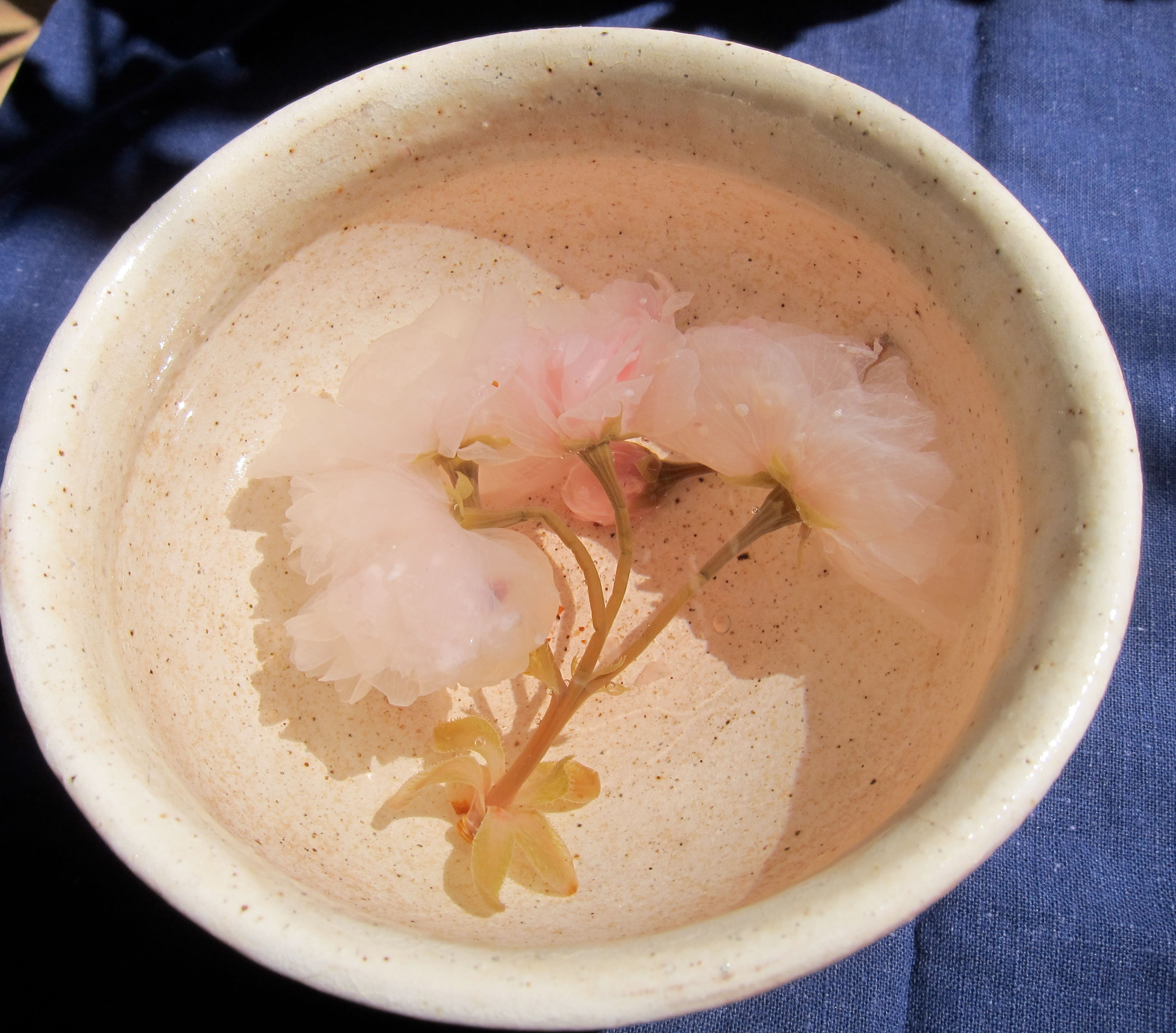
For Japanese cuisine in the month of April in Japan, the choices and flavors are an extension of March cuisine. The seafood catch is great in April as are the new vegetables of the season. And then there’s a range of Japanese sweets like Sakura mochi (cherry rice cakes wrapped in cherry leaves!) that are sold at festivals and street stalls.
Sakura Cherry Blossom Tea: After all the cherry blossoms have fallen and you have returned to your country with pink Japan memories, you can still relive them. That’s right! Sakura cherry blossoms preserved in salt last for years. When placed in boiled water they unfold and float to the top of your cup creating a very dreamy picture. This unique tea can be purchased in all high-end department store food basements and at specialty shops. Just ask!!! This tea, often packaged in fine cherry bark covered containers, is a really special gift to share with friends and family back home.
April seafood picks: The Japanese seafood catch in April is one of the best of the year (as the cold months yield the best fish with few exceptions). In April, you can look forward to excellent seafood cuisine wherever you go. April is the best month for shirasu whitebait fish, the boiled and partially dried fry (baby fish) of the sardine family. The small, see-through (white when cooked) fish are delicious and very nutritious! Other April seafood favorites include small but tasty sakura ebi shrimp, hotoruika firefly squid, hamaguri clams, asari baby clams (often found in a good miso soup bowl), anago salt-water conger eel, and sayori needlefish.
April vegetable highlights: Spring cabbage (haru kyabetsu), sweet, “wet” onions (tamanegi), fresh takenoko bamboo shoots (mostly from warmer Kyushu in April and then Tokyo-Kyoto in May), nutritious nanohana rapeseed dishes, and zesty myoga Japanese ginger (the first of the year!)
April traditional Japanese sweets: April, mostly because of Sakura cherry blossom madness, is a great month for sampling Japan’s unique range of traditional sweets. Sakura mochi: Pink cherry mochi rice cakes are super popular in April. They are made of pink-colored mochi (pounded rice) filled with red-bean paste and wrapped in a pickled cherry leaf. There are two main varieties of sakuramochi: one from Kanto (Tokyo) and the other from Kansai (Kyoto | Osaka). Kanto sakuramochi has a thin layer of a pancake-like wrap made using wheat flour on the outside. In Kansai, glutinous rice is crushed to form a soft ball stuffed with anko red bean paste.These “picnic perfect” Japanese sweets can be found in many convenience stores and all good supermarkets. Just ask! Taiyaki fish cakes: Taiyaki fish cakes are a big favorite with foreigners in the still chilly days of April as they are served warm (with either a white custard or a bean paste filling).
Japan April travel tree and flower highlights
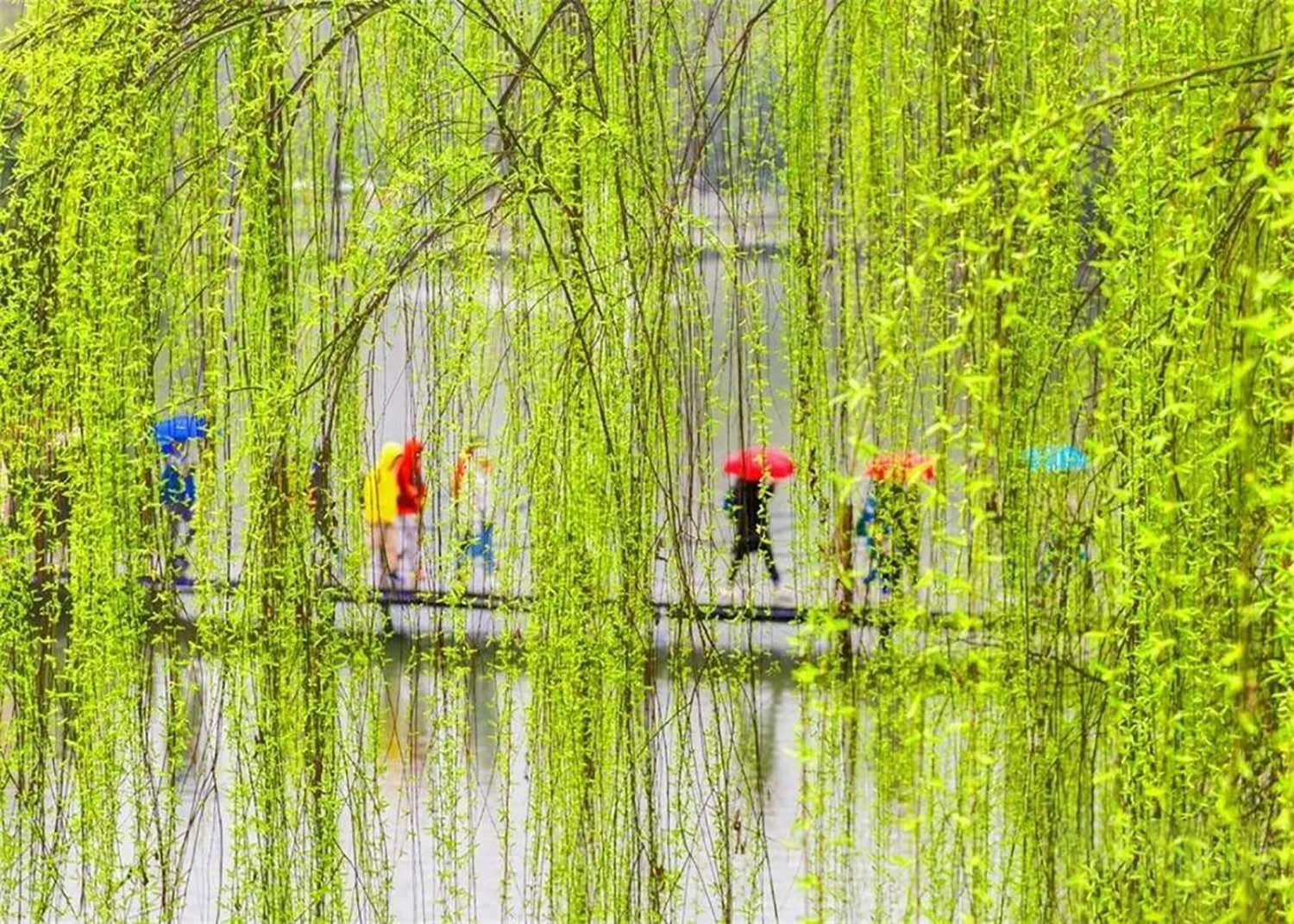
April is really about one flower and one flower only for most foreign travellers: Sakura cherry blossoms! Sakura bloom across Japan’s massive north-south range starting in the south (with the exception of the strangely early cherry blossoms of Kawazu on the warm side of the Izu Peninsula just west of Tokyo). Japan Guide's annual Cherry Blossom Forecast report is perfect for planning sakura experiences on your April trip to Japan.
Other April flowering plants and bushes: Naeshiro rice seedlings: In late April in rice farming areas between Tokyo and Hiroshima foreign tourists should look for the planting of the first naeshiro rice seedings of the year. Yanagi willow jewel leaves: Willow trees in March and April across much of Japan appear like green jewel necklaces swinging in the wind. Rhododendron flowers: Asia is especially famous for its wide range of rhododendrons and Japan is wellknown for these flowering bushes and their striking vermilion, red, or red-purple flowers. In April look for Kurumetsutsuji (Rhododendron obtusum Planch) or "Kirishima,” Yamatsutsuji (Rhododendrom obtusum; found more in the mountains and hills), and Shiroyamabuki (Rhodotypos scandens; also a natural mountain type but also popular in classic Japanese gardens).
Japan April travel event & festival highlights
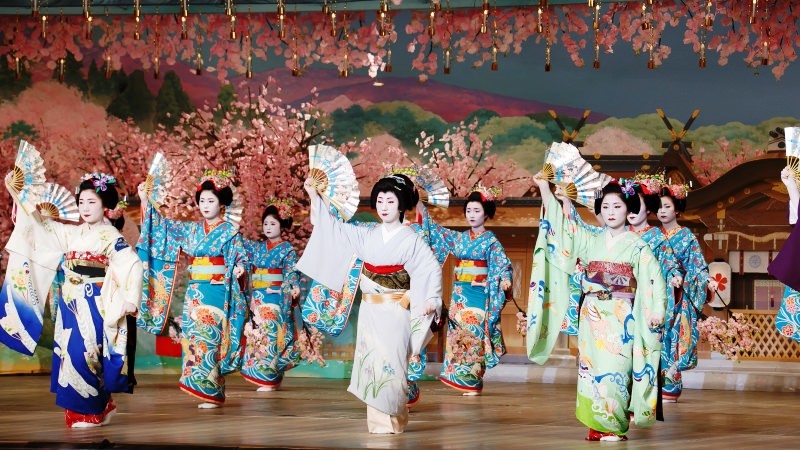
Tateyama Kurobe Alpine Route (mid-April to late Nov.; Toyama area): The dramatic Tateyama Kurobe Alpine Route is famous for its 20-meter-high (65 foot) snow walls and attracts many foreign travelers from the hot and steamy worlds of southeast Asia. Inuyama Festival (early April; just north of Nagoya): This amazing festival, dating back to 1635, features 13 antique floats that are several stories tall. These massive floats are paraded through the narrow streets of Inuyama town with impressive skill. Takayama Spring Festival (April 14-15; Takayama): This major two-day festival deep in the Japanese Alps is both amazing and super popular with Japanese tourists (so be sure to book your accommodation well in advance!!! Or go as a day trip from Nagoya). Kanamara Festival (April 1; Kawasaki): The Kanamara Matsuri, or “Festival of the Steel Phallus” has become a very popular festival in recent years due to extensive media coverage. The festival features a wide range of phallic symbols and very “wild” scenes. Kyoto Spring Geiko Dances (4/1-5/24): April is also when Kyoto’s geiko quarters stage special, breathtakingly beautiful song and dance performances. The dances, with their richly decorated costumes and spectacular stage sets, are perfect, living examples of Kyoto-style grace and elegance. Details: Miyako Odori (4/1-30): geiko of the Gion district. Kyo Odori (4/2-17): performed by the geiko of Miyagawa-cho. Kitano Odori (4/15-25): performed by the geiko of Kamishichiken, the only district NOT in the downtown area; next to Kitano Tenmangu Shrine. Kamogawa Odori (5/1-24): performed by the geiko of Pontocho. Kamo-Kyokusui no Utage sake and poetry game (late March-early May, various locations across Japan): This elegant game, first played by the nobles of the Heian court, has never lost its popularity with commoners throughout Japan. Sitting by a garden stream, poets in period costume must compose a poem before a red sake cup floats by them. Traditional music is also be played. The most famous location is Kyoto’s Kamigamo Shrine (early April). And on April 29 the event is held in the ancient moss-covered gardens of Jonangu Shrine in south Kyoto. Mibu Kyogen (4/21-29; Kyoto): This exciting, colorful spectacle is famous throughout Japan; all the performers wear masks, some dating back to the 13th century. The action, costumes, and spectacular scenes make this event a special treat that is not to be missed if you’re in Kyoto this month.
- Japan April travel food highlights
- Japan April travel tree and flower highlights
- Japan April travel event & festival highlights
- Japanese expressions for cherry blossom viewing
- April Japanese Folk Tale: Cherry Blossom Old Man
- April interview: Japan’s 16th-generation cherry tree expert
Japanese expressions for cherry blossom viewing
In Japan, even extreme drunkenness is considered to be perfectly acceptable behavior – a fact you can easily verify by visiting any of the famous cherry-viewing spots at night. There is nothing quite like sake consumed under a cherry tree in full bloom to make one feel like one has gone to heaven. And it should come as no surprise, that both sake and hana (flowers) appear in a number of Japanese old sayings. Here are two to get you in the mood for hanami, the beloved Japanese tradition of cherry blossom-viewing.
Hana yori dango: “Sweet dumplings rather than flowers” – is a proverb that encourages one to choose the concrete over the ethereal, and has its English equivalent in “Bread is better than bird song”.
Ryote ni hana: “A flower in each hand” – refers to the fortunate condition of having two good things at once. It is almost always used to describe a man who finds himself in the enviable situation of having a woman on either side.
For those interested in a deeper look at the associations between Japanese language and April cherry blossoms consider these. The hana ikada flower raft of deep mountain Yoshino, in a way, Japan’s most famous cherry viewing spot. Hatsu sakura: first cherry blossoms. Hana no kage: shadow of cherry blossoms. The unkin cloud brocade, referring to a hillside covered with pink clouds of cherry blossoms.
And to tell if the flower you are seeing in a painting or scroll is a cherry blossom or a plum blossom remember: cherry blossom petals are drawn with an indentation at their tips, while plum blossom petals are rounded and have no indent. Also a plum trees branches zig zag and there are less flowers, less showy. The plum is an imported tree from China while the cherry is native to both Japan and China.
April Japanese Folk Tale: Cherry Blossom Old Man
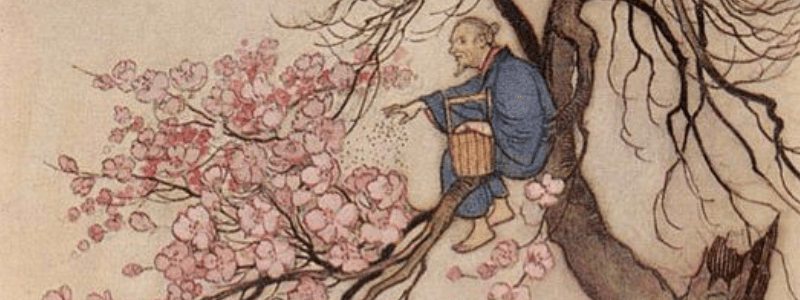
Long, long ago, a kind old man and his wife lived on a mountain. One day when the old man was working in the field, a puppy ran to him for help run after by a bad old man. ‘Help me, or I'll be killed by that bad old man,’ said the puppy. Then the bad old man came and said, ‘This is my dog. He ate my fish. I'll kill him.’ ‘Please forgive this dog. If you kill him, I will buy him from you,’ said the kind man. The bad man sold the dog to him.
The kind old man and his wife loved him. They named the dog Pochi. One day he went up a mountain with Pochi. Suddenly Pochi barked. ‘Dig here, dig here, bow-wow.’ When he dug there, he found lots of gold and silver and other treasure!
When the bad man heard about it, he stole Pochi and took him to another mountain and made him bark. ‘Dig, here.’ Pochi said. However, when the bad old man dug there he found many snakes instead. He got really angry and killed Pochi.
The kind old man was very sad for Pochi and made a grave for him in the garden. Soon a great tree grew up from the grave and a strange voice was heard from somewhere.
‘Make a mortar of this tree.’ said the voice. He cut down the tree and made a mortar. When he put rice into it, the rice changed into gold coins!! Hearing this, the bad old man stole the mortar and put rice into it, but nothing happened. He became very angry and destroyed it in the fire. The kind old man and his wife were very disappointed and went home with the left over ashes. The ash, however, was miraculous and could make cherry trees bloom in an instant.
One day the kind old man was invited to the house of a lord. He scattered the ashes between the branches of the cherry trees and they suddenly started to blossom. The lord was very pleased and gave him a large reward.
The bad man soon heard the story and tried to do the same magic for the lord. But he only succeeded in getting ash into the lord's eyes. The lord became very angry and put the bad man in jail.
Clearly goodness triumphs over evil . . .
- Japan April travel food highlights
- Japan April travel tree and flower highlights
- Japan April travel event & festival highlights
- Japanese expressions for cherry blossom viewing
- April Japanese Folk Tale: Cherry Blossom Old Man
- April interview: Japan’s 16th-generation cherry tree expert
April interview: Japan’s 16th-generation cherry tree expert
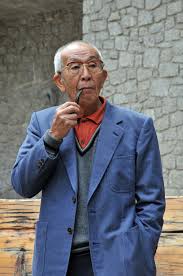
Born in 1928 in Kyoto, Sano Toemon is well-known as Japan’s “Dr. Cherry.” A graduate of Kyoto University’s Settsu Farm program, Mr Sano is the 16th generation head of Uetoyo, which specializes in Japanese garden design and maintenance. Experienced with cherries and gardens in many countries, he has received special awards for his work from UNICEF and the Japanese government. Currently, he is the director of the Japan Cherry Blossom Association, and a senior advisor for the Kyoto Prefectural Landscape Gardening Cooperative Association. [Ian Martin Ropke, YJPT founder and owner, conducted this interview in February 2002.]
YJPT: Your family has been passing on its wisdom and expertise for more than 400 years. What did you learn from your elders?
Sano Toemon: My father and my grandfather taught me many things. But the first and foremost lesson was to learn to call people to you without using your voice. Although it might sound strange, at first, this philosophy or wisdom is essential and precious to human success. It’s all about getting people to trust you by doing things right and working very hard.
Only in this way can we establish our reputation and our worth. People judge us and value us on the basis of our actions and work. My father and my grandfather taught me all this with one single instruction.
In any occupation or situation that has a tradition or history work skills and knowledge, and sometimes even wisdom, are passed from the old to the young. So even though I was the eldest son of the boss, I had to learn things the hard way like everyone else. Naturally, I had a lot to learn. I still do. Education is lifetime process. It ends the moment you die and not one second before.
YJPT: What is the history of cherry blossom viewing? How did it all begin?
Sano Toemon: The Japanese tradition of flower viewing probably first begin in Asuka or Nara about 1,400 years ago, and was mostly an aristocratic form of celebration. In the beginning, people probably looked at plum blossoms more than cherry trees. On another level, though, the yearly cycle of both of these trees is strongly linked with the all-important rice planting cycle. When the flowers come it is time for the farmer to start think about getting the fields and the seedlings ready. The cherry blossom season, because it is slightly later, is a key moment. It’s the moment that both ends the off-season for the farmer and starts the cycle all over again. In the yearly cycle of agricultural life and therefore all Japanese life, the arrival of cherry season is eagerly anticipated and intensely celebrated. It’s the beginning of life again, another year, another circle, another chance to feel young and intoxicated by spring one more time.
The modern tradition of flower viewing and hanami parties began at the end of the 16th century when Japan entered the long peaceful and very prosperous Edo period. Suddenly, everyone had more time to relax and, naturally, the level of celebration became more elaborate and luxurious. Spring, as everyone knows, is start of the mating season in the animal world. The Japanese also followed their instincts. What better way to advertise an unmarried daughter’s skills and beauty, than a cherry viewing party? And if it wasn’t a daughter, then it was a way of showing off the abilities of the wife. Under the trees, the men would open their multi-level lacquered luncheon boxes and share or show off their food. Before long, women also began to actively show off their clothing, accessories and husbands at cherry blossom viewing events. From the Genroku period (1688-1704) on, cherry-blossom parties became a common and much loved part of the year for many people, not just the upper classes.
YJPT: Are cherry trees found in all parts of Japan? How many native species are there?
Sano Toemon: Cherry trees grow wild all over Japan, from Hokkaido to Kyushu. There are only two natural kinds. The early-flowering higanzakura [the equinox cherry, which blooms around the vernal equinox, or March 21] and yamazakura [mountain cherry]. All the other trees, like the wildy popular someiyoshino, are hybrids that were first developed about 150 years ago at the end of the Edo period.
In Kyoto, there are cherry trees nearly everywhere, so you can do hanami [cherry blossom viewing] almost anywhere. Kyoto is the only Japanese city with a population over one million where you can actually see the bottom of the rivers and the mountains are so nearby. The city also has the ideal climatic conditions for cherry trees. Nearly 70 percent of Kyoto’s wind comes from the northwest or the Japan Sea.
YJPT: As a tree specialist, what do you do when a client calls?
Sano Toemon: Nowadays, almost all of my time is spent dealing with sick or dying cherry trees. For this reason, most of the garden design side of the business is in my eldest son’s hands. To keep cherry trees at their very best you need to be around them all year round. It’s the same as raising children. Unfortunately, I have too many children all over Japan that are not very healthy. The most common cherry tree problem is that the soil has gone bad. Usually, this is because the ground water is no longer clean and so the tree slowly sickens. The relationship between the tree and the soil is the most important one.
YJPT: As a man of much experience and who is now passing his wisdom to his grandchildren, what are your feelings about modern Japan?
San Toemon: Sad as it may seem, I feel that modern Japanese ways, most of them based totally on Western ways, have killed our traditional, original culture. Everything that was unique about our civilization has been abandoned. We have stopped wearing our traditional clothing, the kimono. We have largely given up our traditional rice-based diet in favour of meat, bread and pasta . And we have stopped living in homes made of natural materials like mud, wood, bamboo and tile.
Today, people are far too concerned with the search for a more comfortable life. Most of this comfort is based on machine culture. We have lost the wisdom of our ancestors. The biggest problem is that we are to easily satisfied with the comfort of Western ways. Our education system has stopped teaching our children what is important—the origin of Japanese culture. Everything in Japanese culture comes from and is intimately connected with the rice growth cycle. Young people today have no idea how rice grows and so they know almost nothing about their own culture. Rice matures through a series of key seasonal stages. Children should know and experience all of them.
To get back on the right track, we should look to nature, as we always have. Nature determines what is possible and correct for human beings. For this reason, I feel the present economic recession is good for us. People learn best from hardship. It’s hard to forget a bad experience. As you say in the West, failure is the best teacher.
In my family we try as much as possible to do everything together. We eat together and we work together. Our house has an extra-big ofuro [bathing room] where all of us, the grandchildren, children and the adults bathe, talk and relax together. The conversation and teaching tradition between the grandchildren and the grandparents is probably the most important. It is this relationship that allows the very best in culture and essential wisdom to be passed on.
YJPT: Do you have a personal message to convey to foreign tourists?
Sano Toemon: When you come to Kyoto, please think about your own culture and how it is different or like Kyoto. If you are visiting in April, think about your hometown in April. I love my work because Japanese gardens and cherry trees communicate beauty and unique nature of Japanese culture to the world. I make and care for Japanese gardens in many countries. Every garden I create is designed to blend with the surrounding nature, people and culture. Before doing anything, I talk to the old people in the area. They know what I need to know to do my job right. Old people know that the best time to see cherry blossoms is in morning sunshine. They know this is the natural face of this flower. Old people know everything we seem to have forgotten.
Japan month by month private travel & culture summary index
Japan spring travel: Mar, April, May. Learn more!
Japan summer travel: June, July, August. Learn more!
Japan autumn travel: Sept, Oct, Nov. Learn more!
Japan winter travel: Dec, Jan, Feb. Learn more!
Content by Ian Martin Ropke, owner of Your Japan Private Tours (est. 1990). I have been planning, designing, and making custom Japan private tours on all five Japanese islands since the early 1990s. I work closely with Japan private tour clients and have worked for all kinds of families, companies, and individuals since 1990. Clients find me mostly via organic search, and I advertise my custom Japan private tours & travel services on www.japan-guide.com, which has the best all-Japan English content & maps in Japan! If you are going to Japan and you understand the advantages of private travel, consider my services for your next trip. And thank you for reading my content. I, Ian Martin Ropke (unique on Google Search), am also a serious nonfiction and fiction writer, a startup founder (NexussPlus.com), and a spiritual wood sculptor. Learn more!